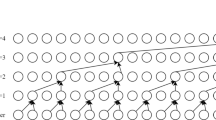Abstract
The paper presents a system for monitoring and assessment the speech quality in the IP telephony infrastructures using modular probes. The probes are placed at key nodes in the network where aggregating packet loss data. The system dynamically measures speech quality and results are collected on a central server. For data analysis we applied four-state Markov model for modeling the impact of network impairments on speech quality, afterwards, the resilient back propagation (Rprop) algorithm was used to train a neural network. Information about the speech quality are displayed in the form of automatically generated graphs and tables. The proposed solution has been tested with selected codecs and further generalizes the already presented concepts of the speech quality estimation in the IP environment.






Similar content being viewed by others
References
Rezac, F., Voznak, M., & Tomala, K. (2015). Voice Messaging System as a Form of Distribution of an Urgent Information. Wireless Personal Communications, 85(1), 63–76.
ITU-T, Recommendation P.862.1: Mapping function for transforming P.862 raw result scores to MOS-LQO. International Telecommunication Union (2004)
Rango, F., Tropea, M., Fazio, P., & Marano, S. (2006). Overview on VoIP: Subjective and objective measurement methods. International Journal of Computer Science and Network Security, 6(1), 140–153.
De Rango, F., Fazio, P., Scarcello, F., & Conte, F. (2014). A new distributed application and network layer protocol for VoIP in mobile ad hoc networks. Mobile Computing, IEEE Transactions on, 13(10), 1233–1536.
Frnda, J., Voznak, M., Rozhon, J., & Mehic, M. (2012). Prediction Model of QoS for Triple Play Service. In 21st Telecommunications Forum TELFOR, pp. 733-736. Belgrade.
Hecht, J. (2014). All smart, no phone. Spectrum, IEEE, 51(10), 36–41. New York.
Pocta, P., Holub, J., & Mrvova, M. (2009). Impact of different active-speech-ratios on PESQ’s predictions in simulated VoIP environment. Acta Acustica united with Acustica, 95(5), 950–957.
Kadioglu, R., Dalveren, Y., & Kara, A. (2015). Quality of service assessment: A case study on performance benchmarking of cellular network operators in Turkey. Turkish Journal of Electrical Engineering and Computer Sciences, 23(2), 548–559.
Sunder, D.S., & Kushwaha, R.K. (2015). Evaluation of narrow band speech codecs for Ubiquitous Speech Collection and Analysis Systems. In xtitProceedings International Conference on Industrial Instrumentation and Control, ICIC 2015, art. no. 7150718, pp. 93–98
Raake, A. (2007). Speech quality of VoIP: Assessment and prediction. Chichester: John Wiley & Sons.
Khan, H. A., & Sun, L. (2008). Assessment of speech quality for VoIP applications using PESQ and E-Model. Advances in Communications, Computing, Networks and Security, 7, 263–273.
Sun, L., & Ifeachor, E. C. (2006). Voice quality prediction models and their application in VoIP networks. IEEE Transactions on Multimedia, 8(4), 809–820.
Fazio, P., De Rango, F., & Selvaggi, I. (2010). A novel bandwidth reservation algorithm based on neural networks path prediction in wireless environments. In Proceedings International Symposium on Perf. Evaluation of Computer and Telecommunication Systems (SPECTS 10), Ottawa.
De Rango, F., Tropea, M., Santamaria, A. F., & Marano, S. (2007). An enhanced QoS CBT multicast routing protocol based on Genetic Algorithm in a hybrid HAPSatellite system. Computer Communications, 30(16), 3126–3143.
Meky, M., & Saadawi, T. (1997). Prediction of speech quality usingradial basis functions neural networks. In Proceedings of Second IEEE Symposium on Computers and Communications, Alexandria, pp.174–178.
Mrvova, M., & Pocta, P. (2013). Quality estimation of synthesized speech transmitted over IP channel using genetic programming approach. In Proceedings International Conference on Digital Technologies (DT), Zilina, pp. 39–43.
Rozhon, J., Rezac, F., Slachta, J., & Voznak, M. (2014). Monitoring of speech quality in full-mesh networks. Communications in Computer and Information Science, 431, 157–166.
OpenWRT-Wireless Freedom, https://openwrt.org/
Summerfield, M. (2013) Python in Practice: Create Better Programs Using Concurrency, Libraries, and Patterns, 1st edition. Addison-Wesley Professional, Indiana
Barret, D. J., Silverman, R. E., & Byrnes, R. G. (2005). SSH, The secure shell: The definitive guide (2nd ed.). Sebastopol: O’Reilly Media.
Paramiko - SSH2 Protocol for Python, http://www.lag.net/paramiko/
Klucik, S., Chromy, E., & Baronak, I. (2015). Model to Increase the Number of Output States of a Random Variable Using a Histogram Based PDF. Wireless Personal Communications, 85(1), 137–149.
Burget, R., Komosny, D., & Ganeshan, K. (2012). Topology aware feedback transmission for real-time control protocol. Journal of Network and Computer Applications, 35(2), 723–730.
Igel, C., & Husken, M. (2000). Improving the Rprop Learning Algorithm. In Proc. of the Second International Symposium on Neural Computation, NC2000, ICSC Academic Press, 115–121.
Elliot, D. (1993). A Better Activation Function for Artificial Neural Networks. ISR Technical Report TR 93-8, University of Maryland.
Friedman, T., Caceres, R., & Clark, A. (2003). RTP Control ProtocolExtended Reports (RTCP XR). IETF Network Working Group, RFC 3611.
Clark, A. (2001). Modeling the Effects of Burst Packet Loss and Recency on Subjective Voice Quality. Colombia: IPtel Workshop.
Voznak, M., Rezac, F., & Rozhon, J. (2013). Speech quality assessment using computational E-model and its implementation. International Journal of Mathematics and Computers in Simulation, 7(3), 277–285.
Author information
Authors and Affiliations
Corresponding author
Rights and permissions
About this article
Cite this article
Orcik, L., Voznak, M., Rozhon, J. et al. Prediction of Speech Quality Based on Resilient Backpropagation Artificial Neural Network. Wireless Pers Commun 96, 5375–5389 (2017). https://doi.org/10.1007/s11277-016-3746-2
Published:
Issue Date:
DOI: https://doi.org/10.1007/s11277-016-3746-2




